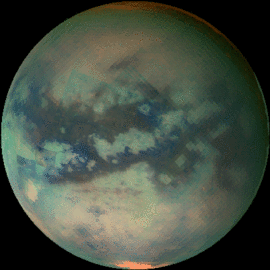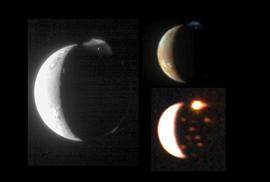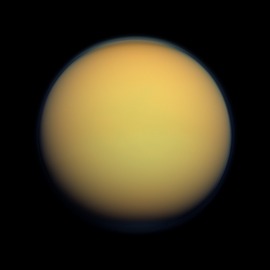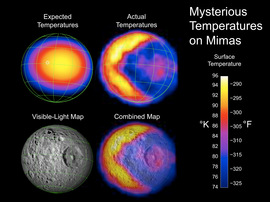Moons
Infrared light has shown the hidden sides of many moons in our Solar System, from the volcanic hellhole of Io to the methane lakes and icy volcanoes of Titan, and the mysterious temperature patterns on the surface of Mimas.
A moon is defined as a celestial body that makes an orbit around a planet.
Volcanic Io
Io is the innermost of Jupiter's four Galilean moons; the other three in order of distance from the gigantic planet are Europa, Ganymede and Callisto. Images of Io taken in visible light show a barren yellow and orange sulfur-covered landscape, scarred with dark spots that hint at the violent nature of the moon.
Looking in the infrared, the true nature of Io's surface is revealed, with huge bright hotspots tracing the massive volcanoes that rage across its surface. With more than 400 known volcanoes, Io is the most geologically active object in the Solar System.
Moons can also be called "satellites" but this word is usually used to describe man-made objects.
Infrared Imaging
Io's geologic activity is the result of “tidal heating” -- the moon gets squeezed and stretched as it’s tugged around by the gravity of Jupiter and the other big moons, Europa, Ganymede, and Callisto. Just as an elastic band warms up as you stretch it over and over again, the inside of Io heats up too, causing massive volcanic eruptions.
Infrared observations allow astronomers to easily pinpoint the volcanoes that are still active, allowing them to differentiate between current and old volcanic activity. Several of Io’s volcanoes produce plumes of sulfur and sulfur dioxide that climb as high as 500 km (300 mi) above the surface, and are easily seen in images like the one above. A plume can be spotted in the upper right corner of the moon, in the same area as the bright hot patch in the infrared image to the lower right. By splitting the light from Io using a spectrograph, astronomers were able to identify the molecular "fingerprints" of the sulfur and sulfur dioxide in the light.
Frigid Titan
Titan, Saturn's largest moon, is an icy, rocky moon. It has clouds of methane and ethane, and is the only moon in the Solar System with a thick atmosphere. The atmosphere is so thick, in fact, that visible light simply can’t see through it.
Until 2004, astronomers had very little idea of what the surface of Titan looked like. Scientists speculated about whether the moon was likely to be completely dry, or have lakes of ethane or methane, or maybe have massive oceans of methane that covered the whole surface.
Cassini-Huygens
In 2004, the Cassini-Huygens mission settled the argument: as the Huygens probe dropped into Titan’s atmosphere on a parachute, it beamed back images of a rocky surface with lakes and rivers of some kind of liquid.

Cassini continued to study Titan using infrared light, which is better at penetrating Titan’s thick atmosphere than visible light. Cassini’s instruments confirmed that the lake near Titan’s south pole, called Ontario Lacus, is made of liquid ethane.
Infrared images have also revealed areas of light and dark terrain near Titan’s equator, as well as brownish dune fields, and bright terrain that scientists think is caused by freezing-cold volcanoes, with “lava” made of ammonia and ice. These volcanoes are so cold that scientists have called them “cryovolcanoes.”
Titan's Atmosphere
The structure of Titan's atmosphere was mapped using Cassini's infrared instruments, with the hazy atmosphere color-coded in magenta, and cloud cover over the Southern hemisphere appearing yellow.
For more about flying on other planets and moons, see Randall Monroe's calculations for an interplanetary airplane.
Titan's atmosphere is immense, extending over 700 kilometers (435 miles) above the surface, and adding about a third to the size of Titan. It's mostly made of methane, but contains some carbon monoxide too. The atmosphere is so thick, and the gravity so low, that humans would likely be able to fly by flapping artificial wings. The temperature is so low, though (around -200C or -330F) that we'd need a very warm space suit!
Mystery of Mimas
Mimas is Saturn's small inner moon. It’s just 396 kilometers in diameter (246 miles), and has a very strange pattern of daytime temperatures, which are being studied in the infrared.
Looking at Mimas in visible light, there is a huge crater on the surface called Herschel crater. Astronomers were curious about the temperature patterns on the moon, and whether the crater would affect how Mimas is heated by the Sun. To study this, they took infrared images of the surface, giving them a heat map of the moon.
Instead of the smoothly changing temperatures that we see on most moons, Mimas is divided into a warm part (in yellow), and a cold part (in purple), with a sharp V-shaped boundary between them. Typical temperatures on the warm part are near 92 K (-294 F), and typical temperatures on the cold part are near 77 K (-320 F).
Scientists think the cold part is colder because some kind of unidentified surface material on Mimas is allowing the Sun's energy to soak into the subsurface of the moon instead of only warming the surface, but why the transfer of heat varies so dramatically is still a big mystery. The cold side includes the giant Herschel Crater, which is a few degrees warmer than its surroundings and so shows up in pink. Scientists think that the crater may, in some unknown way, be responsible for the large region of cold temperatures that surrounds it.
Published: 02 August, 2013






